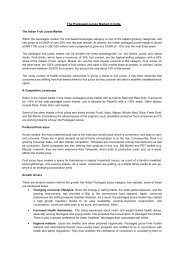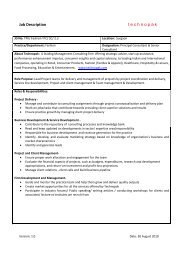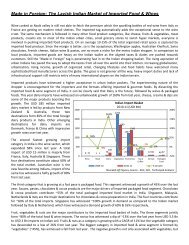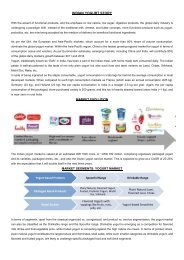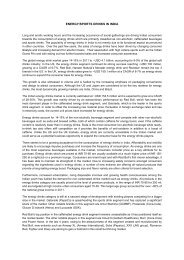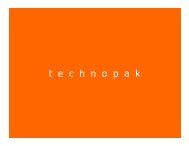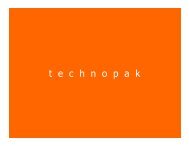India's Home Products Market – Contradictions ... - Technopak
India's Home Products Market – Contradictions ... - Technopak
India's Home Products Market – Contradictions ... - Technopak
Create successful ePaper yourself
Turn your PDF publications into a flip-book with our unique Google optimized e-Paper software.
<strong>India's</strong> <strong>Home</strong> <strong>Products</strong><br />
<strong>Market</strong> <strong>–</strong> <strong>Contradictions</strong>,<br />
Challenges, Opportunities<br />
Arvind Singhal<br />
Chairman, <strong>Technopak</strong> Advisors
Structure Of The Presentation<br />
India’s Consumption Priorities<br />
What Next <br />
Suggestions<br />
Conclusions<br />
2/25
India’s<br />
Consumption<br />
Priorities …
India’s Consumption Basket (Key Categories)<br />
(All Figs in US$ Billion) 2010 2015* 2020*<br />
Food & Grocery 308 400 500<br />
Pharmacy, Wellness & Healthcare 60 120 250<br />
Telecom Services, <strong>Home</strong> Electronics/ Appliances<br />
& Personal IT products<br />
44 75 125<br />
Education (K-12, higher education, vocational &<br />
coaching)<br />
33 55 90<br />
Apparel & <strong>Home</strong> Textiles 33 45 60<br />
Personal transport (vehicles + fuel + repairs +<br />
insurance)<br />
30 48 75<br />
Jewellery & Watches 23 37 65<br />
Travel & leisure 15 25 40<br />
<strong>Home</strong> <strong>–</strong> Furniture & Hard Furnishings 13 20 30<br />
Hotels, Restaurants, & Cafes 6 12 25<br />
* Estimates, based on various trends<br />
All figures in constant 2012 $<br />
1US$ = Rs 50<br />
4/25
Indian <strong>Home</strong> Textiles <strong>Market</strong> Growing Modestly @ 8% CAGR <strong>–</strong><br />
Barely Keeping Pace With Inflation<br />
INR Cr<br />
50,000<br />
40,000<br />
Domestic <strong>Home</strong> Textile <strong>Market</strong><br />
30,000<br />
20,000<br />
18,400<br />
10,000<br />
CAGR : 8%<br />
27,360<br />
40,800<br />
INR Cr<br />
Category wise <strong>Market</strong> Breakup<br />
Categories 2011 2016(P) 2021(P)<br />
CAGR<br />
2011-21<br />
Bed Linen 8965 13170 19350 8%<br />
Towels 3320 4840 7060 8%<br />
Curtains 1850 2975 4790 10%<br />
Blankets 1465 2040 2850 7%<br />
Upholstery 1190 1915 3080 10%<br />
Kitchen Linen 1110 1635 2400 8%<br />
-<br />
2011 2016 (P) 2021 (P)<br />
Rugs & Carpets 500 790 1250 9.5%<br />
Total 18,400 27,360 40,800 8%<br />
5/25
Per Capita Consumption Of <strong>Home</strong> Textiles Abysmally Low In India<br />
Compared Even With Developing <strong>Market</strong>s Like Brazil & China<br />
<strong>Market</strong> Size (US$ Billion)<br />
50.0<br />
40.0<br />
30.0<br />
20.0<br />
10.0<br />
0.0<br />
<strong>Market</strong> Size & Per Capita Consumption of <strong>Home</strong> Textiles<br />
Global Average Per capita<br />
consumption: $23<br />
India China Brazil US<br />
<strong>Market</strong> Size<br />
Per capita consumption<br />
Per Capita<br />
Consumption. ($)<br />
140.0<br />
120.0<br />
100.0<br />
80.0<br />
60.0<br />
40.0<br />
20.0<br />
0.0<br />
Annual per capita consumption of home textiles is about US$3 (About Rs 150) in<br />
India compared to world average of US $23 (About Rs 1200)<br />
6/25<br />
Source: NBS, cib.eu, US census, Websearch, <strong>Technopak</strong> Analysis
So, Naturally, Leading Indian <strong>Home</strong> Textile Companies<br />
Are Export Focussed<br />
2011<br />
2010<br />
2009<br />
2008<br />
2007<br />
2011<br />
2010<br />
2009<br />
2008<br />
2007<br />
2011<br />
2010<br />
2009<br />
2008<br />
2007<br />
Turnover: Export Vs. Domestic<br />
0% 20% 40% 60% 80% 100%<br />
Exports<br />
Domestic<br />
Trident Alok<br />
Himatsingka<br />
2011 Revenue<br />
(Rs Crore)<br />
1107<br />
1000<br />
490<br />
Export of <strong>Home</strong> Textiles (Mn $)<br />
2,261<br />
CAGR : 12%<br />
2,261<br />
736<br />
2000 2005 2010<br />
Unit Value Realization<br />
Export $ 11.5 / Kg<br />
Domestic $ 8 / Kg<br />
Low unit value realization and highly unorganized market structure are deterring factors<br />
7/25
Less Than Stellar Performance Of Pioneers In<br />
Indian <strong>Market</strong> ...<br />
• Several notable attempts from some very strong and able<br />
textile companies to crack the domestic home textiles &<br />
furnishings market, but spectacular success still elusive …<br />
• DCM<br />
• Bombay Dyeing<br />
• Raymond<br />
• SKNL<br />
• GHCL<br />
• Welspun<br />
• Himatsingka<br />
• Others ….<br />
8/25
Could They Have Done Something Different <br />
• Almost all have tried the usual, intuitive strategies and<br />
almost have backed it up with requisite managerial<br />
and financial resource to attempt :<br />
• Design & product innovation<br />
• Multiple price point segmentation <strong>–</strong> from mass to premium<br />
• Branding<br />
• Exclusive retail stores / Shop-in-shops<br />
• <strong>Market</strong>ing & promotions including Point Of Sales activations<br />
• Metros to Pan-India penetration<br />
9/25
So, What Next
A Few Reality Checks … Indian Consumer<br />
• Indian consumers’ behavior perplexing not only<br />
when it comes to home textiles and furnishings but a<br />
many other categories too e.g.<br />
• Oral care (toothpaste & tooth brushes) (annual per capita<br />
spend < Rs 50)<br />
• Footwear (annual per capita spend < Rs 350)<br />
• Ready-to-eat processed meals (not snack foods) (annual<br />
per capita spend < Rs 40)<br />
11/25
A Few Reality Checks … Indian Consumer<br />
• Indian consumers are spending at higher-than-GDP-growth<br />
rate levels in many other home categories including:<br />
• Paints<br />
• Furniture<br />
• Kitchen appliances and furnishings (e.g. chimneys)<br />
• Bathroom fittings<br />
• Flooring and floor coverings<br />
• CAGRs in the last five years generally in the range of 15% (or<br />
even higher) while home textiles have languished at about 8%<br />
- perhaps due to a rapid increase in acquisition of new homes<br />
and increasing nuclearization of households<br />
12/25
Trend : Increasing Time Poverty<br />
• Convenience would be one of the defining “themes”<br />
in the current decade:<br />
• Several parameters of convenience which include:<br />
• Access (ease and time)<br />
• Decision (information, ease of making choice, and time)<br />
• Transaction (ease and time)<br />
• Timing (flexibility)<br />
13/25
ICE AGE COPPER AGE IRON AGE MODERN<br />
DIGITAL<br />
…2.5M BC<br />
8000 BC 3500 BC 1500 BC 400 AD 1600 1900 2010 2015…….<br />
STONE AGE<br />
BRONZE AGE MEDIEVAL EARLY DIGITAL<br />
14/25
Trend : Geographically Spreading <strong>Market</strong><br />
• Indian market is moving beyond the classic segmentation of<br />
Metros, mini Metros, capitals of large states, and then tiered<br />
definition of cities<br />
• Widespread investment activity is creating new economic<br />
hotspots almost all across India, and with this, purchasing<br />
power is rapidly spreading pan-India<br />
• With universal reach of media, consumer and market trends<br />
getting disseminated across India almost in real time, with<br />
little lag between rest of the world and India, and then<br />
between Metros and rest of India<br />
15/25
2020 : Emergence Of New Economic Hot Spots<br />
• High investment activity has lead to the creation of new economic hot spots<br />
27<br />
93<br />
3<br />
13<br />
8<br />
14<br />
42<br />
13<br />
9<br />
3<br />
9<br />
10<br />
7<br />
26<br />
22<br />
13<br />
38<br />
17<br />
58<br />
6<br />
15<br />
19<br />
53<br />
41<br />
13<br />
9<br />
32<br />
96<br />
5<br />
19<br />
16<br />
59<br />
5<br />
16<br />
3<br />
1<br />
11<br />
3<br />
19<br />
31<br />
92<br />
10<br />
2<br />
1 3<br />
7 21<br />
3<br />
4<br />
4<br />
4<br />
1<br />
11 51<br />
3<br />
Hotspots<br />
Number of Moons<br />
India will see the emergence of<br />
~350 Hot Spots & Over 1,000<br />
Moons <strong>–</strong> areas of high economic<br />
activity<br />
Though consumers will have the<br />
propensity to buy, the lack of<br />
access & availability to products &<br />
services locally will lead to growth<br />
of alternate retail channels<br />
Also, conventional model of<br />
modern retail will not be able to<br />
offer all formats or cater to all<br />
customer groups in these hotspots<br />
16/25
Suggestions …
1: Invest In Better Understanding Of Consumer &<br />
<strong>Market</strong><br />
• India is undergoing several fundamental shifts (economic,<br />
demographic, ambitions and aspirations, economic activity<br />
hotspots<br />
• <strong>Home</strong> textiles and home products’ market dynamics may be<br />
poised for some fundamental shifts too, and at a take-off<br />
point<br />
• Hence, the industry as a whole should come together to<br />
invest in a very comprehensive, pan-India market and<br />
consumer insights study and then use the findings to identify<br />
new trends, segments, and develop specific strategies<br />
18/25
2: Develop Some Product Ranges (And Retail Channels)<br />
Only For Gifting Purpose<br />
• India has an estimated annual US$30<br />
billion gifting market<br />
• <strong>Home</strong> décor, home electronics / small<br />
appliances are the existing big categories<br />
in the space<br />
• <strong>Home</strong> textiles can also tap this opportunity<br />
using both B2C and B2B route by<br />
developing special product ranges only for<br />
gifting purpose with appropriate packaging<br />
19/25
3: Event / Occasion Specific Collections<br />
• Occasion specific: e.g. Wedding collection /<br />
housewarming collection / Silver<br />
and Golden wedding anniversary<br />
collection etc.<br />
• Event specific : e.g. Diwali / Holi<br />
• Retailer specific :<br />
Exclusive product range / cobranded<br />
products with leading<br />
retail chains and for upcoming<br />
pure-play e-tailers<br />
20/25
4: Explore E-tailing Enthusiastically<br />
• E-tailing in India will grow @ about 75% CAGR over the next decade, and<br />
likely to reach US$ 60-75 Billion by 2020<br />
• <strong>Home</strong> textiles and home-furnishings are very suitable products for E-<br />
tailing channel<br />
• No challenge on size / fit<br />
• Less issues with “touch and feel”<br />
• Easy to pack and ship<br />
• E-channel can provide a much better medium for stocking of a much wider<br />
range and actually much more effective product display<br />
• Negligible incremental cost in reaching out to customers in small cities and<br />
upcoming hot-spots<br />
21/25
To Conclude ….
Conclusions …<br />
• The hitherto slow growth of domestic home textiles market,<br />
and the slower growth in customers’ willingness to upgrade<br />
qualitatively, quantitatively, and pricewise is a conundrum<br />
that needs to be researched and analyzed more intensively<br />
• Other home categories showing very encouraging growth, and<br />
so perhaps a tipping point for home textiles and furnishings<br />
may also be around the corner<br />
• Some product-usage based and channel-based segmentations<br />
could offer new opportunities to stimulate domestic demand<br />
23/25
Thank You<br />
Very Much !
For Further Dialogue, Please Contact :<br />
Arvind Singhal<br />
Chairman,<br />
<strong>Technopak</strong> Advisors (India)<br />
T : (+91) 124 454 1111<br />
E : arvind.singhal@technopak.com<br />
Web : www.technopak.com



